Математическое моделирование распространения вирусов с длинной инкубационной фазой в тесном мире
Аннотация
Рассмотрена модель распространения вирусов в отдельных городах и в сети городов с учетом запаздывания, вызванного длительным инкубационным периодом вируса. Показано влияние эффектов запаздывания в сравнении с пандемиями без такого запаздывания. Выявлена временная асимметрия распространения инфекции, означающая, что время развития пандемии значительно превышает время ее завершения. Проведены модельные расчеты распространения вирусов в сети связанных между собой больших и малых городов и выявлены особенности динамики в сравнении с распространением вирусов в моногороде, в том числе возможность повторного инфицирования мегаполисов из внешнего резервуара инфекции. При выбранных параметрах запаздывания, длительность и амплитуда пандемии увеличивается в несколько раз по сравнению с пандемией вирусов с короткой инкубационной фазой.
Скачивания
Литература
2. Fisher, R. A. The wave of advance of advantageous genes / R. A. Fisher // Ann. Eugenics. – 1937. – V. 7. – P. 353–369.
3. Griffiths, G. W. Kolmogorov–Petrovskii– Piskunov Equation. Traveling Wave Analysis of Partial Differential Equations / G. W. Griffiths, W. E. Schiesser. – Elsevier, Amsterdam, 2012. – 461 p.
4. El-Hachem, M. Revisiting the Fisher-Kolmogorov-Petrovsky-Piskunov equation to interpret the spreading-extinction dichotomy / M. El-Hachem [et al.] // Proceedings of the Royal Society A: Mathematical, Physical and Engineering Sciences. – 2019. – V. 475. – V. 2229. – P. 20190378.
5. Longini, I. M. A mathematical model for predicting the geographic spread of new infectious agents / I. M. Longini // Mathematical Biosciences – 1988. – V. 90(1-2). – P. 367–383.
6. Nokkaew, A. Mathematical modeling of infectious disease transmission in macroalgae / A. Nokkaew [et al.] //Adv. Differ. Equ. 2017. – No 288. – P. 1–8.
7. Liu, J. Modeling disease spread via transport-related infection by a delay differential equation / J. Liu, J. Wu, Y. Zhou // Rocky Mountain J. Math. – 2008. – V. 38 (5). – P. 1525–1540.
8. Misra, A. K. Modeling the effect of time delay in controlling the carrier dependent infectious disease – Cholera / A. K. Misra [et al.] // Applied Mathematics and Computation. – 2012. – V. 218(23). – P. 11547–11557.
9. Chen, T. A mathematical model for simulating the phase-based transmissibility of a novel coronavirus / T. Chen [et al.] // Infect. Dis. Poverty. – 2020. – V. 9. – No 24. – P. 1–8.
10. Lin, Q. A conceptual model for the coronavirus disease 2019 (COVID-19) outbreak in Wuhan, China with individual reaction and governmental action / Q. Lin [et al.] // International Journal of Infectious Diseases. – 2020. – V. 93. – P. 211–216.
11. Tang, B. An updated estimation of the risk of transmission of the novel coronavirus (2019- nCov) / B.Tang [et al.] // Infectious Disease Modelling. – 2020. – V. 5. – P. 248–255.
12. Wu, J. T. Nowcasting and forecasting the potential domestic and international spread of the 2019-nCoV outbreak originating in Wuhan, China: a modelling study / Joseph T. Wu, Kathy Leung, Gabriel M. Leung // Lancet. – 2020. – V. 395. – P. 689–97.
13. Kobayashi, H. System Modeling and Analysis: Foundations of System Performance Evaluation / Hisashi Kobayashi, Brian L. Mark. – NJ, Pearson Education, 2008. – 782 p.
14. Golovinski, P. A. Scenarios of destruction for large network and increasing reliability / P. A. Golovinski // arXiv:1310.2468. – 2013. – P. 1–6.
15. Chen, D. Modeling the Spread of Infection Diseases: A Review. Analyzing and Modeling Spatial and Temporal Dynamics of Infection Diseases / D. Chen; book Editor(s): Dongmei Chen, Bernard Moulin, Jianhong Wu. – Hoboken John Wiley & Sons, 2015. – P. 19–44.
16. Arino, J. Some methodological aspects involved in the study by the Bio. Diaspora Project of the spread of infectious diseases along the global air transportation network / J. Arino [et al.] // Canadian Applied Mathematics Quarterly. – 2012. – V. 19. – P. 125–137.
17. Bian, L. A network model for dispersion of communicable diseases / L. Bian, D. Liebner // Transactions in GIS. – 2007. – V. 11(2). – P. 155–173.
- Авторы сохраняют за собой авторские права и предоставляют журналу право первой публикации работы, которая по истечении 6 месяцев после публикации автоматически лицензируется на условиях Creative Commons Attribution License , которая позволяет другим распространять данную работу с обязательным сохранением ссылок на авторов оригинальной работы и оригинальную публикацию в этом журнале.
- Авторы имеют право размещать их работу в сети Интернет (например в институтском хранилище или персональном сайте) до и во время процесса рассмотрения ее данным журналом, так как это может привести к продуктивному обсуждению и большему количеству ссылок на данную работу (См. The Effect of Open Access).



















